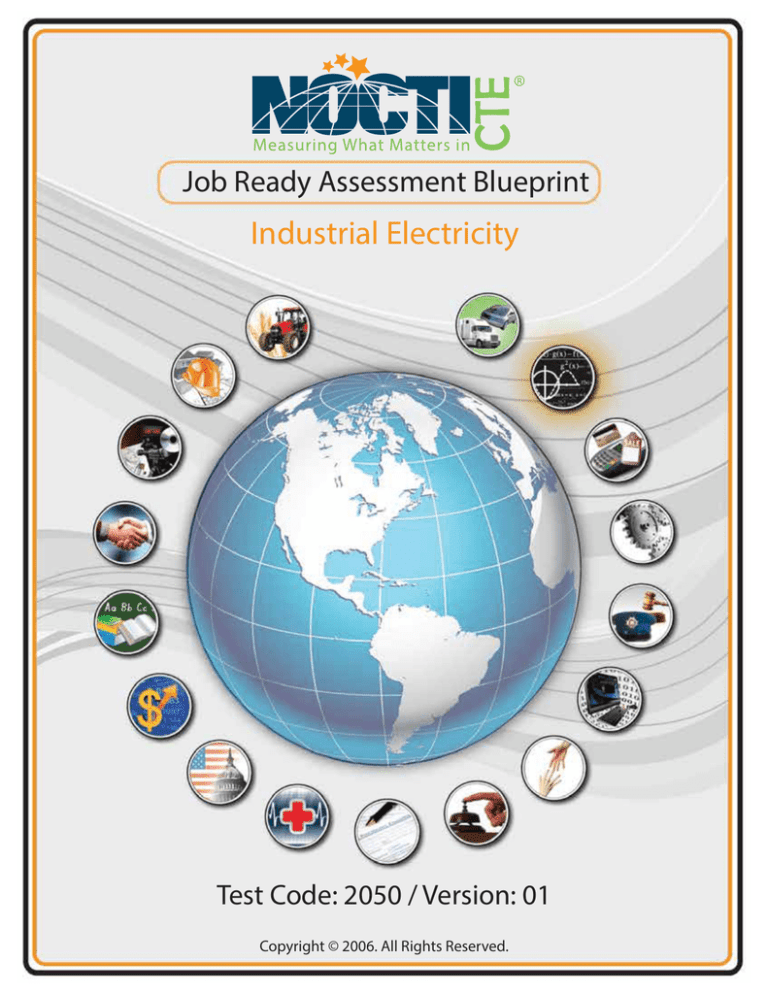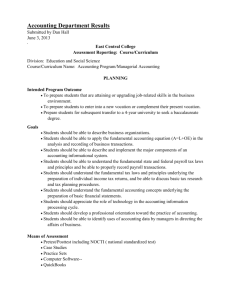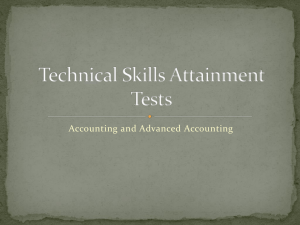
Job Ready Assessment Blueprint
Industrial Electricity
Test Code: 2050 / Version: 01
Copyright © 2006. All Rights Reserved.
Industrial Electricity
General Assessment Information
Blueprint Contents
General Assessment Information
Sample Written Items
Written Assessment Information
Performance Assessment Information
Specific Competencies Covered in the Test Sample Performance Job
Test Type: The Industrial Electricity industry-based credential is included in NOCTI’s Job
Ready assessment battery. Job Ready assessments measure technical skills at the
occupational level and include items which gauge factual and theoretical knowledge.
Job Ready assessments typically offer both a written and performance component and
can be used at the secondary and post-secondary levels. Job Ready assessments can
be delivered in an online or paper/pencil format.
Revision Team: The assessment content is based on input from secondary,
post-secondary, and business/industry representatives from the states of Connecticut,
Kentucky, New Jersey, North Carolina, Ohio, and Pennsylvania.
CIP
Code
47.0105- Industry Electronics
Technology/Technicians
Career Cluster 15Science, Technology, Engineering,
and Mathematics
49-2094.00- Electrical
and Electronic Repairers
In the lower division
baccalaureate/associate degree
category, 3 semester hours in
Industrial Electricity
(Continued on the following page)
NOCTI Job Ready Assessment
Page 2 of 11
Industrial Electricity
General Assessment Information (continued)
The Association for Career and Technical Education (ACTE), the leading professional
organization for career and technical educators, commends all students who
participate in career and technical education programs and choose to validate their
educational attainment through rigorous technical assessments. In taking this
assessment you demonstrate to your school, your parents and guardians, your future
employers and yourself that you understand the concepts and knowledge needed to
succeed in the workplace. Good Luck!
The International Sign Association (ISA) represents manufacturers,
suppliers and users of on-premise signs and sign products from all 50
states and around the globe. The sign and visual communications
industry is a $37.5 billion business that employs more than 200,000
individuals. One of ISA’s long term goals is to showcase and promote
the many exciting and diverse career opportunities that exist within
the sign and visual communications industry and to apprise students
of the abundant employment opportunities that are present to
skilled and qualified candidates. ISA strongly encourages and
supports students that work to enhance their educational
achievements by completing NOCTI assessments.
NOCTI Job Ready Assessment
Page 3 of 11
Industrial Electricity
Written Assessment
NOCTI written assessments consist of questions to measure an individual’s factual
theoretical knowledge.
Administration Time: 3 hours
Number of Questions: 191
Number of Sessions: This assessment may be administered in one, two, or three sessions.
Areas Covered
DC Theory
7%
AC Theory
7%
6%
Test Equipment
11%
Electrical Drawings
8%
General Wiring
National Electrical Code
6%
9%
Electrical Controls
Generators
3%
17%
Motors
Transformers
Variable Frequency
Drives (VFDs)
Programmable Logic
Controllers (PLCs)
Safety
NOCTI Job Ready Assessment
8%
4%
6%
8%
Page 4 of 11
Industrial Electricity
Specific Standards and Competencies Included in this Assessment
DC Theory
• Demonstrate knowledge of principles of DC theory
• Apply Ohm’s Law and Kirchoff’s Law
• Solve series and parallel circuits
• Calculate power formulas
AC Theory
• Calculate inductive reactance
• Calculate capacitive reactance
• Demonstrate knowledge of principles of AC theory
• Calculate waveforms and frequency
Test Equipment
• Test circuits for opens and continuity
• Test circuits for voltage, current, and resistance
• Demonstrate proper care and use of test equipment
Electrical Drawings
• Identify electrical symbols
• Interpret electrical wiring drawings
• Troubleshoot from electrical drawings
General Wiring
• Select, measure, and cut conduit
• Ream, thread, and bend conduit
• Install boxes, fixtures, and hardware
• Select proper enclosures
• Identify and use electrical fittings
(Continued on the following page)
NOCTI Job Ready Assessment
Page 5 of 11
Industrial Electricity
Specific Standards and Competencies (continued)
National Electrical Code
• Define the purpose, intent, and jurisdiction of the NEC
• Identify proper conductor type and size
• Size pull boxes
• Demonstrate proper grounding and bonding procedures
Electrical Controls
• Identify and connect switches, sensors, and relays
• Exhibit understanding of motor starters
• Understand principles of circuit protection
Generators
• Determine the output of a generator
• Identify the internal components of a generator
Motors
• Identify motor circuits
• Identify and define types of motors
• Identify and explain motor components
• Connect leads for operation
• Test for operation
• Troubleshoot and diagnose problems
Transformers
• Identify types of transformers
• Identify leads and connections
• Calculate voltage
• Calculate amperage
• Calculate KVA capacity
(Continued on the following page)
NOCTI Job Ready Assessment
Page 6 of 11
Industrial Electricity
Specific Standards and Competencies (continued)
Variable Frequency Drives (VFDs)
• Demonstrate proper set up and installation
• Exhibit knowledge of basic programming
• Troubleshoot VFDs
Programmable Logic Controllers (PLCs)
• Demonstrate proper set up and installation
• Exhibit knowledge of basic programming
• Troubleshoot PLCs
Safety
• Exhibit basic knowledge of OSHA standards
• Identify appropriate personal protective equipment (PPE)
• Demonstrate knowledge of correct scaffolding and ladder procedures
• Demonstrate proper selection and use of hand and power tools
NOCTI Job Ready Assessment
Page 7 of 11
Industrial Electricity
Sample Questions
Materials with a low resistance are called
A. insulators
B. potential
C. emf
D. conductors
Conductors at the junctions of switchpoints or outlets must have a minimum length
of
A. 3 inches
B. 6 inches
C. 9 inches
D. 12 inches
Shaded-pole motors have _______ starting torque.
A. very high
B. very low
C. medium
D. maximum
The primary winding of a transformer is rated at 480V and 600 turns. If the
secondary is rated at 120Vs, the secondary has _______ turns.
A. 150
B. 400
C. 1600
D. 2400
A _______ is a device used to safely remove cartridge fuses from electrical
enclosures.
A. insulated side cutter
B. pulling pliers
C. insulated cartridge pliers
D. fuse puller
(Continued on the following page)
NOCTI Job Ready Assessment
Page 8 of 11
Industrial Electricity
Sample Questions (continued)
One form of the equation for electrical power in a DC circuit is
A. P = I2E
B. E = P ÷ I
C. E = P x I
D. R = P ÷ E
A generator
A. changes electrical energy to mechanical energy
B. changes mechanical energy to electrical energy
C. is always self-excited
D. is always separately excited
The direction of rotation of a shaded-pole motor is
A. clockwise
B. counterclockwise
C. from main pole to shaded pole
D. from shaded pole to main pole
Select the correct wiring configuration on a 120 VAC output card for a
programmable logic controller (PLC).
A. L2 (N) to the card and L1 (H) to the field devices
B. L1 (H) to the card and L2 (N) to the field devices
C. L2 (N) to the card and ground to the field devices
D. L1 (H) to the card and ground to the field devices
A GFCI on a 120V circuit operates by sensing an imbalance of
A. voltage between hot and ground
B. voltage between hot and neutral
C. current between hot and ground
D. current between hot and neutral
NOCTI Job Ready Assessment
Page 9 of 11
Industrial Electricity
Performance Assessment
NOCTI performance assessments allow individuals to demonstrate their acquired skills by
completing actual jobs using the tools, materials, machines, and equipment related to the
technical area.
Administration Time: 3 hours and 20 minutes
Number of Jobs: 4
27%
14%
Areas Covered:
14% Tools and Materials Identification
Participants will identify tools and materials correctly, and
write neatly and legibly on the identification form.
25%
34%
27% Conduit Bending
Participants will safely use the tools, ream and thread the conduit, and accurately measure
lengths for a correct appearance of the conduit.
34% Wiring a Motor Starter
Participants will safely use the correct tools and conductors to label and number wires
correctly, meet workmanship criteria, operate the motor and clean up the work area.
25% Replacing Ballast in a Fluorescent Fixture
Participants will safely use the correct tools to install a ballast, meet the criteria for
professional work, and operate the fluorescent fixture.1
NOCTI Job Ready Assessment
Page 10 of 11
Industrial Electricity
Sample Job
Replacing Ballast in a Fluorescent
Maximum Time: 20 minutes
Participant Activity: The participants will go to a designated station, remove and
replace the ballast in the fluorescent fixture that is provided, test for operation, and
notify the evaluator so that the work can be inspected.
NOCTI Job Ready Assessment
Page 11 of 11




